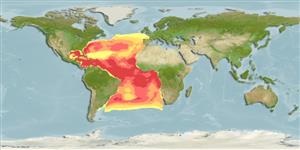Mammalia |
Cetartiodactyla |
Delphinidae
Environment: milieu / climate zone / djupintervall / distribution range
Ekologi
Pelagiska; djupintervall 0 - 4500 m (Ref. 86752). Tropical; 90°N - 90°S, 180°W - 180°E
Atlantic Ocean. Tropical, subtropical.
Length at first maturity / Size / Weight / Age
Könsmognad: Lm ? range ? - ? cm Max length : 200 cm TL hane/ej könsbestämd; (Ref. 1394); publicerad maxvikt: 85.0 kg (Ref. 1394)
Feeds on small fish and squid at moderate depths, presumably mainly at night (Ref. 1394). Minimum depth from Ref. 116169. Feeds on small fish and squid at moderate depths, presumably mainly at night (Ref. 1394).
Life cycle and mating behavior
Könsmognad | Reproduktion | Lek | Eggs | Fecundity | Larvae
Jefferson, T.A., S. Leatherwood and M.A. Webber 1993 FAO species Identification Guide: Marine Mammals of the World. Rome, FAO. 320 p. + 587 figures. (Ref. 1394)
IUCN Red List Status
(Ref. 130435: Version 2025-1)
CITES status (Ref. 108899)
Threat to humans
Human uses
Fiskeri: kommersiell
FAO - fiskeri: landings, species profile | FishSource | Sea Around Us
Verktyg
Ytterligare information
Trophic EcologyFood items (preys)FödosammansättningFödointagPredatorer Population dynamicsTillväxt
Max. ages / sizes
Length-weight rel.
Length-length rel.
Length-frequencies
Mass conversion
Abundans
Life cycleReproduktion
Könsmognad
Fecundity
Lek
Eggs
Egg development
Larvae
PhysiologySyreförbrukning
Human RelatedStamps, coins, misc.
Internet-källor
Estimates based on models
Preferred temperature
(Ref.
115969): 2.2 - 10.9, mean 3.6 (based on 2536 cells).
Fishing Vulnerability
Very high vulnerability (90 of 100).
Price category
Unknown.
